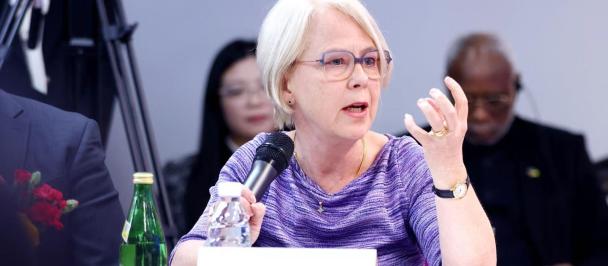
Good evening! It is my pleasure to speak at tonight’s reception to celebrate International Women’s Day! Ambassador Burns thank you for the invitation!
Technologies and innovation are rapidly reshaping our societies and economies, and redefining how people live, work, and interact. They also offer cutting-edge solutions to our most urgent global challenges.
However, we can’t maximize the benefits of these technologies and fully harness them to advance sustainable development, without the involvement of women in how they are designed and deployed.
The quantum leaps required to get the world back on track to achieve the Sustainable Development Goals simply won’t be possible if the brainpower of half the world, remains untapped. Nor will they matter, if we create a future where half the world gets left behind.
Excluding women from the digital economy not only further widens divides by limiting access to the future of work. It also has massive macro-economic consequences. According to a UN Women report, it has already cost $1 trillion from the GDP of low & middle-income countries over the last decade.
That is why the theme for this year’s women’s day, on digital inclusion or “DigitALL”, is so important. Gender equality in STEM and the digital economy goes beyond women themselves. It impacts all of humanity.
Worldwide, the gender disparity in tech fields is significant. Only roughly a third of STEM students are female. This is also the case in China.
This disparity results in biases, which in turn reinforce disparities. Let me give you two examples: Only 17% of venture capital goes to female-led tech startups pointing to a visible lack of investor trust. And, AI-powered recruitment systems that generally learn from male dominated employment patterns tend to rate male job applicants higher.
That said, this scenario is not inevitable. We know the remedies. Let me zoom in on four entry points in particular.
Firstly, we need to nurture girl’s interest in STEM from an early age. We know that girls get interested in STEM by the age of 11, but begin turning away at 15.
- Schools need to not only ensure that girls have equal access to technology and digital skills trainings. They should also proactively seek out female students for STEM programs with dedicated initiatives to foster interest in STEM subjects.
Secondly, we need to change attitudes and create role models.
- Public awareness efforts are critical to dispel the incorrect notion that women are not good in STEM – including in the minds of girls themselves.
- Profiling inspiring examples and creating role models also is a powerful tool. At Tsinghua University, for the first time in its history, female scientists now hold the top two leadership positions in the Department of Computer Science.
Thirdly, we need to look at employers:
- Gender considerations need to be incorporated into hiring and employment practices in tech and STEM sectors
- This includes gender-sensitive job advertisements and gender balanced hiring panels.
- To retain women, address the “so-called” leaky pipeline and nurture careers along - trainings, networking opportunities and mentorship programmes can make an important contribution.
- More flexible working arrangements that accommodate the needs of working mothers, including nursing rooms, also have to be part of the mix.
- Beyond this, tech companies should be encouraged to publicly release gender composition of their R&D teams, which could help incentivize greater participation of women. This in fact makes business sense. Harvard Business Review found that companies that tap female expertise in product design for women consumers improve their likelihood of success by 144%. [1]
- In STEM research, academic institutions should extend the age limit for female candidates applying for research grants to accommodate maternity breaks. This practice is already starting to take hold in China - with some science foundations having increased the age from 35-40.
Fourthly, we need policies that address the structural barriers to women’s participation in the digital economy and STEM.
- We need laws that end discrimination and inequality both in access to finance and at the workplace.
- We also need greater public investment in childcare services, including nurseries and daycare centers.
- Increasing both maternity and paternity leave can also help to balance the burden of care, while reducing the pressure on women having to choose between family and a career. Cities like Beijing and Shanghai have increased the maternity leave by 30 days over the national mandatory requirement to 158 days.
At UNDP, here in China we are working with UN Women and the UN system to empower and engage more women in STEM and tech fields. Let me share a four highlights:
- Through our annual #HERStory campaign, we are working to shine a spotlight on female role models. The campaign shares stories of women leaders in STEM to inspire girls and combat gender biases.
- This year, we are also working with partners to organize a STEM bootcamp for teenage girls thanks to funding from the Government of Japan.
- We will also be releasing a new policy brief shortly, examining the challenges to increasing women’s participation in tech and science in China & the Region, and provide policy recommendations on structural changes needed.
- Globally, UNDP is also working with UNICEF on the “STEM4ALL” initiative – a platform that aims to nurture the next generation of girls in STEM through knowledge sharing, and advocacy, to meet the demands of the future of work.
Let me close where I started: with the world facing a multitude of crises from climate change and natural disasters, to conflicts and wars, we truly need all hands on deck.
The game-changing solutions which science and technology offer are more vital than ever.
But we need to see more of them designed both for women, and by women. Only then can we create a more sustainable and inclusive future, where no one is left behind.
[1] https://hbr.org/2013/08/how-women-drive-innovation-and

 Locations
Locations



